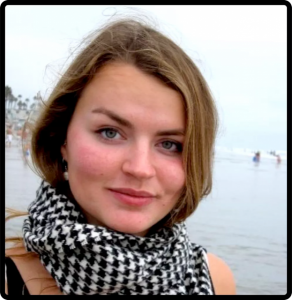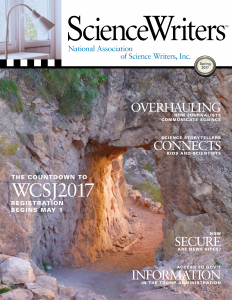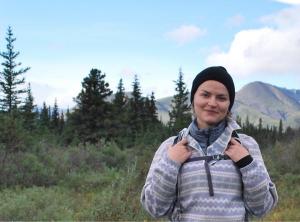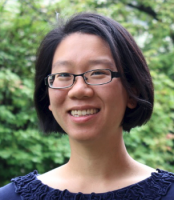By Amy G. McDermott
Thanks to the Council for the Advancement of Science Writing (CASW), I know more about lichens than I ever expected to. And by learning and writing about these funky fungal symbionts, I also got to know the twisting branches of the U.S. Forest Service. This courtesy of a Taylor/Blakeslee Project Fellowship (see sidebar below).It was an introduction to deep-dive feature reporting, which took me further into the field than I had ever gone as a journalist before. It was a chance to build relationships with Forest Service heavyweights like Linda Geiser, head of the air-quality program. And, most importantly, it was a chance to chase great stories.
In August, I traveled to interior Alaska, about an hour outside of Fairbanks. For a week, I worked with field crews as they surveyed the diversity of lichens on rolling tundra and in boreal forest. Every morning, we dressed in orange, flame-resistant flight suits and loaded our backpacks into the undercarriage of a running helicopter (always careful to duck away from the rotor blades). We flew for up to an hour, from a little airstrip over miles of scorched forests, which had been consumed by recent wildfires. On clear days, the hulking mass of Denali, North America's highest peak, loomed beyond the helicopter window. We often landed in blueberry bogs, where sharp, burned trees were less likely to pierce the helicopter's body. We'd put down in knee-deep water, climb out of the chopper — its blades still running above us — and squelch to higher, dryer ground.
Sarah Jovan, a Forest Service lichenologist and my primary point of contact in planning this project, fell ill suddenly and was unable to join me in the field. She sent Rob Smith, a graduate student at Oregon State University who specializes in Alaskan lichens, in her stead. Smith studies the thick carpet of lichens that cover the permafrost in Alaska and lock up a huge amount of carbon. These boreal forests, it turns out, are a big blind spot in climate change research. Alaskan soils and permafrost hold up to 77 billion metric tons of carbon, but some dynamics of the cycle there are not well understood.
The original plan was to travel to Alaska with Jovan as she monitored lichens as ecological sentinels, but with Smith, the focus changed. We still surveyed lichens with the field crews, but we also took soil cores and collected other kinds of vegetation for carbon analysis back in Oregon.After a week in the Alaskan wilderness, I flew to Portland and spent several days with Linda Geiser, hiking in the woods around Mount Hood. We walked through steep, fern-covered hills, and even hacked through a fallen tree, which was blocking a remote road, using only a hand axe. In Oregon, Geiser and I focused on lichen species that are beacons of air quality and environmental health, as outlined in my original reporting proposal.
After leaving Mount Hood, I travelled to Corvallis to meet with Bruce McCune, a lichenologist at Oregon State University in Corvallis, and with Geiser for a second time. We discussed the history and implications of lichen monitoring. Back in Washington, D.C., at the end of August, I wrote up the Oregon work in a cover story for Science News, where I had interned for the summer.
Other stories include a series of blog posts on fieldwork in Alaska and Oregon for the National Geographic Voices blog, as well as a news story for Mongabay that coincided with the Forest Service's release of a national lichen atlas in early 2017. I am writing a second feature on lichens as a tool to understand carbon cycling in boreal forests, which Mongabay has also expressed interest in.One unexpected challenge of this project has been timing these stories for publication in multiple outlets. As an intern at Science News during the summer, and now at Grist, in Seattle, I have not written for other publications. The end of my Science News internship coincides with the release of the lichen atlas, at which point I will publish these additional pieces.
Throughout the Taylor/Blakeslee Project Fellowship, I was confronted with a variety of new challenges, from drafting the proposal and budget, to adapting quickly when Jovan fell ill, to living and working alongside scientists, to writing up a feature based on a mountain of field notes and recordings. Living this project has been one of the greatest learning experiences I've had as a young journalist. It's steered me deeper into longform writing and shown me a reporter's perspective on life in the field. In the future, I hope to travel with scientists again. This first experience leaves me more confident and able to compete as I face new challenges.
Amy McDermott is a journalist and editor, currently based in Santa Cruz, Calif. She is the inaugural recipient of the Taylor/Blakeslee Science Journalism Project Fellowship.
About the Taylor/Blakeslee Project Fellowship
In 2014, CASW executive director Rosalind Reid and then UC Santa Cruz Science Communication Program director Rob Irion had a conversation on ways to expand and enhance the Taylor/Blakeslee University Fellowship program.
Given that most students these days are headed for freelance careers, an idea emerged for a career-launching enterprise project that would give a student the full experience in planning, funding, and pitching a project.
The discussion moved to the CASW board level and then to a proposal to the Brinson Foundation which agreed to fund a $5,000 grant for investigative reporting. The Taylor/Blakeslee Project Fellowship is in addition to the foundation's continuing financial support of the Taylor/Blakeslee University Fellowships.
The Taylor/Blakeslee Project Fellowship is currently open only to Taylor/Blakeslee University Fellows who can apply for a project fellowship when they are within six weeks of graduation.
Amy G. McDermott
2nd Taylor Blakeslee Project Fellowship awarded
Jennifer Lu, who is studying toward a master's degree in journalism at the University of Missouri, is the recipient of the second $5,000 special reporting grant from CASW's Taylor/Blakeslee university graduate fellowships program.
In her final semester of the Mizzou master's program, Lu is focusing on investigative and data journalism. Her professional goal is to apply these skills to stories about science, health and the environment. She will use the Taylor/Blakeslee Project Fellowship toward reporting on the urgent problems that come with the nation's aging drinking water infrastructure for the online investigative news group InquireFirst.The judges noted the urgency and importance of investigative science reporting on the drinking water contamination crises now facing many cities. Lu's reporting plan will dig into these issues and examine the effectiveness of practice and regulation at the local, regional, and national levels.
Lu has already published her first story on the topic: "trump could drain great lake's Cleanup Budget: Funding to protect drinking water for 35 million people may be cut 97 percent."
(NASW members can read the rest of the Spring 2017 ScienceWriters by logging into the members area.) Free sample issue. How to join NASW.







